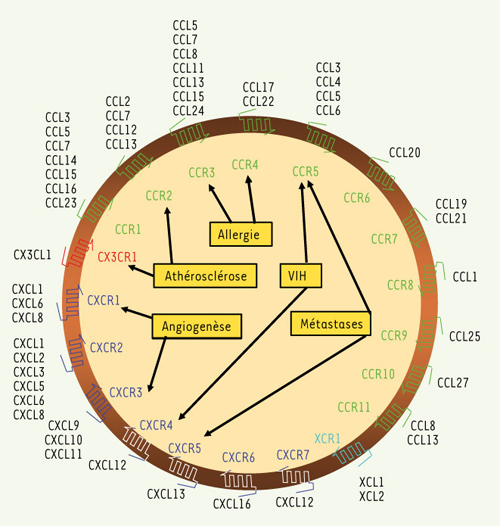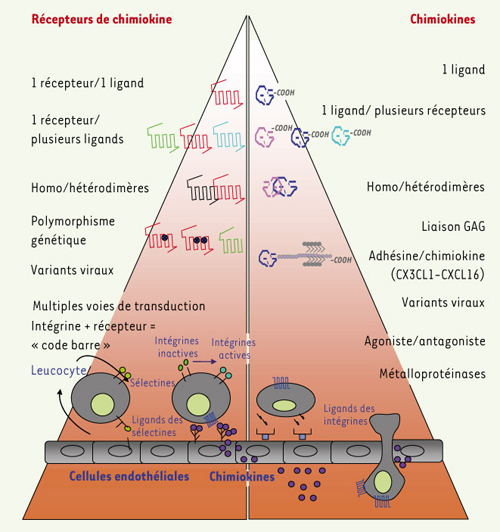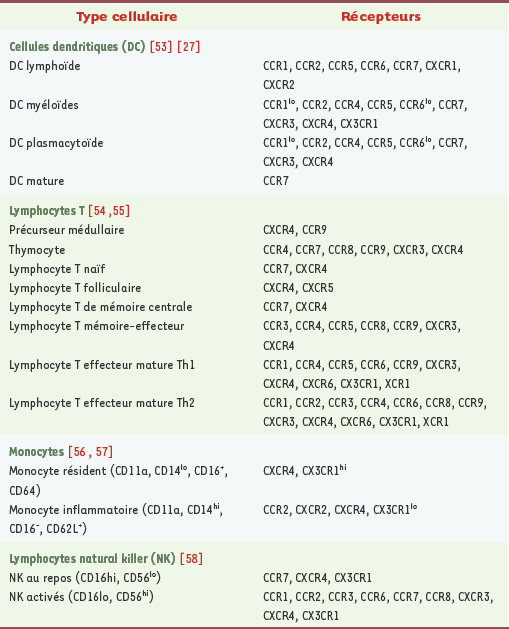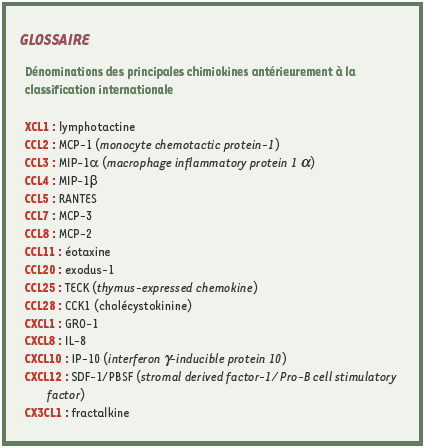1.
Foussat A, Galanaud P, Emilie D. Les chimiokines et la longue marche des leucocytes. Med Sci (Paris) 2000; 16 : 757–66.
2.
Cyster JG. Chemokines, sphingosine-1-phosphate, and cell migration in secondary lymphoid organs. Annu Rev Immunol 2005; 23 : 127–59.
3.
Mantovani A. The chemokine system: redundancy for robust outputs. Immunol Today 1999; 20 : 254–7.
4.
Morange M. Déconstruction de la notion de gène. Med Sci (Paris) 2004; 20 : 835–6.
5.
Luster AD, Alon R, von Andrian UH. Immune cell migration in inflammation: present and future therapeutic targets. Nat Immunol 2005; 6 : 1182–90.
6.
Rot A, Von Andrian UH. Chemokines in innate and adaptive host defense: basic chemokinese grammar for immune cells. Ann Rev Imm. 2004; 22 : 891–928.
7.
Springael JY, Urizar E, Parmentier M. Dimerization of chemokine receptors and its functional consequences. Cytokine Growth Factor Rev 2005; 16 : 611–23.
8.
Bulenger S, Marullo S, Bouvier M. Emerging role of homo- and heterodimerization in G-protein-coupled receptor biosynthesis and maturation. Trends Pharmacol Sci 2005; 26 : 131–7.
9.
Jordan BA, Devi LA. G-protein-coupled receptor heterodimerization modulates receptor function. Nature 1999; 399 : 697–700.
10.
Percherancier Y, Berchiche YA, Slight I, et al. Bioluminescence resonance energy transfer reveals ligand-induced conformational changes in CXCR4 homo- and heterodimers. J Biol Chem 2005; 280 : 9895–903.
11.
El-Asmar L, Springael JY, Ballet S, et al. Evidence for negative binding cooperativity within CCR5-CCR2b heterodimers. Mol Pharmacol 2005; 67 : 460–9.
12.
Chen C, Li J, Bot G, et al. Heterodimerization and cross-desensitization between the [mu]-opioid receptor and the chemokine CCR5 receptor. Eur J Pharmacol 2004; 483 : 175–86.
13.
Lortat-Jacob H, Grosdidier A, Imberty A. Structural diversity of heparan sulfate binding domains in chemokines. Proc Natl Acad Sci USA 2002; 99 : 1229–34.
14.
Proudfoot AE, Handel TM, Johnson Z, et al. Glycosaminoglycan binding and oligomerization are essential for the in vivo activity of certain chemokines. Proc Natl Acad Sci USA 2003; 100 : 1885–90.
15.
Van Den Steen PE, Wuyts A, Husson SJ, et al. Gelatinase B/MMP-9 and neutrophil collagenase/MMP-8 process the chemokines human GCP-2/CXCL6, ENA-78/CXCL5 and mouse GCP-2/LIX and modulate their physiological activities. Eur J Biochem 2003; 270 : 3739–49.
16.
Thelen M. Dancing to the tune of chemokines. Nat Immunol 2001; 2 : 129–34.
17.
Roscic-Mrkic B, Fischer M, Leemann C, et al. RANTES (CCL5) utilizes the proteoglycan CD44 as an auxiliary receptor to mediate cellular activation signals and HIV-1 enhancement. Blood 2003; 24 : 24.
18.
Moatti D, Faure S, Fumeron F, et al. Polymorphism in the fractalkine receptor CX3CR1 as a genetic risk factor for coronary artery disease. Blood 2001; 97 : 1925–8.
19.
Lavergne E, Labreuche J, Daoudi M, et al. Adverse associations between CX3CR1 polymorphisms and risk of cardiovascular or cerebrovascular disease. Arterioscler Thromb Vasc Biol 2005; 25 : 847–53.
20.
Campbell DJ, Kim CH, Butcher EC. Chemokines in the systemic organization of immunity. Immunol Rev 2003; 195 : 58–71
21.
Muller G, Hopken UE, Lipp M. The impact of CCR7 and CXCR5 on lymphoid organ development and systemic immunity. Immunol Rev 2003; 195 : 117–35.
22.
Breitfeld D, Ohl L, Kremmer E, et al. Follicular B helper T cells express CXC chemokine receptor 5, localize to B cell follicles, and support immunoglobulin production. J Exp Med 2000; 192 : 1545–52.
23.
O’Garra A, McEvoy LM, Zlotnik A. T-cell subsets: chemokine receptors guide the way. Curr Biol 1998; 8 : R646–9.
24.
Rabin RL, Park MK, Liao F, et al. Chemokine receptor responses on T cells are achieved through regulation of both receptor expression and signaling. J Immunol 1999; 162 : 3840–50.
25.
Morris MA, Ley K. Trafficking of natural killer cells. Curr Mol Med 2004; 4 : 431–8.
26.
Ancuta P, Moses A, Gabuzda D. Transendothelial migration of CD16+ monocytes in response to fractalkine under constitutive and inflammatory conditions. Immunobiology 2004; 209 : 11–20.
27.
Caux C, Vanbervliet B, Massacrier C, et al. Regulation of dendritic cell recruitment by chemokines. Transplantation 2002; 73 : S7–11.
28.
Murphy PM. Viral exploitation and subversion of the immune system through chemokine mimicry. Nat Immunol 2001; 2 : 116–22.
29.
Hatabu T, Kawazu S, Aikawa M, et al. Binding of Plasmodium falciparum-infected erythrocytes to the membrane-bound form of Fractalkine/CX3CL1. Proc Natl Acad Sci USA 2003; 100 : 15942–6.
30.
Onuffer J, Horuk R. Chemokines, chemokine receptors and small-molecule antagonists : recent developments. Trends Pharmacol Sci 2002; 23 : 459.
31.
Reape TJ, Groot PH. Chemokines and atherosclerosis. Atherosclerosis 1999; 147 : 213–25.
32.
Bursill CA, Channon KM, Greaves DR. The role of chemokines in atherosclerosis: recent evidence from experimental models and population genetics. Curr Opin Lipidol 2004; 15 : 145–9.
33.
Elsner J, Escher SE, Forssmann U. Chemokine receptor antagonists: a novel therapeutic approach in allergic diseases. Allergy 2004; 59 : 1243–58.
34.
Charo IF, Ransohoff RM. The many roles of chemokines and chemokine receptors in inflammation. N Engl J Med 2006; 354 : 610–21.
35.
Hancock WW, Lu B, Gao W, et al. Requirement of the chemokine receptor CXCR3 for acute allograft rejection. J Exp Med 2000; 192 : 1515–20.
36.
Haskell CA, Hancock WW, Salant DJ, et al. Targeted deletion of CX(3)CR1 reveals a role for fractalkine in cardiac allograft rejection. J Clin Invest 2001; 108 : 679–88.
37.
Gao W, Topham PS, King JA, et al. Targeting of the chemokine receptor CCR1 suppresses development of acute and chronic cardiac allograft rejection. J Clin Invest 2000; 105 : 35–44.
38.
Gao W, Faia KL, Csizmadia V, et al. Beneficial effects of targeting CCR5 in allograft recipients. Transplantation 2001; 72 : 1199–205.
39.
Hancock WW, Wang L, Ye Q, et al. Chemokines and their receptors as markers of allograft rejection and targets for immunosuppression. Curr Opin Immunol 2003; 15 : 479–86.
40.
Fischereder M, Luckow B, Hocher B, et al. CC chemokine receptor 5 and renal-transplant survival. Lancet 2001; 357 : 1758–61.
41.
Sgadari C, Angiolillo AL, Tosato G. Inhibition of angiogenesis by interleukin-12 is mediated by the interferon-inducible protein 10. Blood 1996; 87 : 3877–82.
42.
Salcedo R, and Oppenheim JJ. Role of chemokines in angiogenesis: CXCL12/SDF-1 and CXCR4 interaction, a key regulator of endothelial cell responses. Microcirculation 2003; 10 : 359–70.
43.
Balkwill F. Cancer and the chemokine network. Nat Rev Cancer 2004; 4 : 540–50.
44.
Moran CJ, Arenberg DA, Huang CC, et al. RANTES expression is a predictor of survival in stage I lung adenocarcinoma. Clin Cancer Res 2002; 8 : 3803–12.
45.
Ohta M, Tanaka F, Yamaguchi H, et al. The high expression of Fractalkine results in a better prognosis for colorectal cancer patients. Int J Oncol 2005; 26 : 41–7.
46.
Rollins BJ, Sunday ME. Suppression of tumor formation in vivo by expression of the JE gene in malignant cells. Mol Cell Biol 1991; 11 : 3125–31.
47.
Biragyn A, Kwak LW. B-cell malignancies as a model for cancer vaccines: from prototype protein to next generation genetic chemokine fusions. Immunol Rev 1999; 170 : 115–26.
48.
Caux C, Ait-Yahia S, Chemin K, et al. Dendritic cell biology and regulation of dendritic cell trafficking by chemokines. Springer Semin Immunopathol 2000; 22 : 345–69.
49.
Merad M, Fong L, Bogenberger J, et al. Differentiation of myeloid dendritic cells into CD8alpha-positive dendritic cells in vivo. Blood 2000; 96 : 1865–72.
50.
Shedlock DJ, Weiner DB. DNA vaccination: antigen presentation and the induction of immunity. J Leukoc Biol 2000; 68 : 793–806.
51.
Scheerlinck JY. Genetic adjuvants for DNA vaccines. Vaccine 2001; 19 : 2647–56.
52.
Xin KQ, Lu Y, Hamajima K, et al. Immunization of RANTES expression plasmid with a DNA vaccine enhances HIV-1-specific immunity. Clin Immunol 1999; 92 : 90–6.
53.
Sozzani S. Dendritic cell trafficking: more than just chemokines Cytokine Growth Factor Rev 2005; 16 : 581–92.
54.
Moser B, Wolf M, Walz A, et al. Chemokines: multiple levels of leukocyte migration control. Trends Immunol 2004; 25 : 75–84.
55.
O’Garra A, McEvoy LM, Zlotnik A. T-cell subsets: chemokine receptors guide the way Curr Biol 1998; 8 : R646–9.
56.
Geissmann F, Jung S, Littman DR. Blood monocytes consist of two principal subsets with distinct migratory properties. Immunity 2003; 19 : 71–82.
57.
Ancuta P, Rao R, Moses A, et al. Fractalkine preferentially mediates arrest and migration of CD16+ monocytes. J Exp Med 2003; 197 : 1701–7.
58.
Maghazachi AA. Compartmentalization of human natural killer cells. Mol Immunol 2005; 42 : 523–9.





